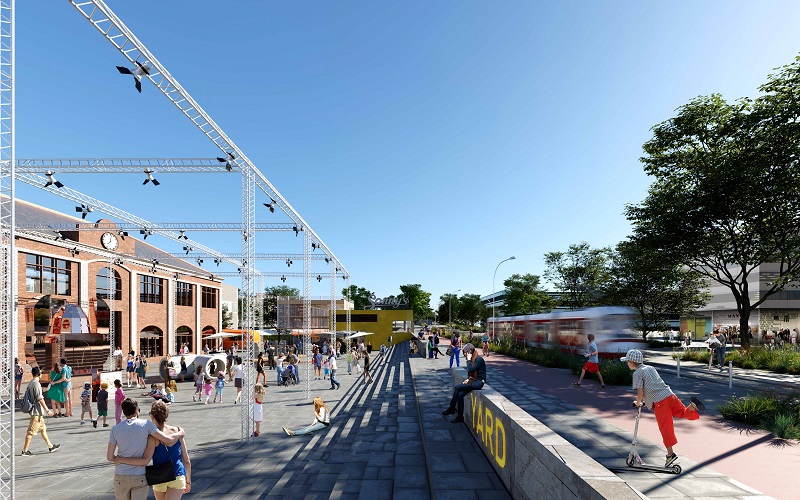Building Briefs - May 18th
- Mactaggart & Mickel bolsters London strategic land team
Mactaggart & Mickel had strengthened its growing strategic land division with a new addition to its London-based team.

Conor Roberts (left) and Ken Hopkins (centre) welcome Nick Rennie to Mactaggart & Mickel’s strategic land division
Nick Rennie has joined Mactaggart & Mickel as strategic land manager South East and will be based in the company’s Paddington Basin office.
He will have responsibility for identifying strategic land opportunities and guiding sites with future development potential through the planning process for the housebuilding market.
Nick is relishing his new role with Mactaggart & Mickel following two-and-a-half years at Bellway Homes North London.
As well as his professional experience, Nick, who hails from Beaconsfield, Buckinghamshire, but now lives in Putney, boasts a Royal Institution of Chartered Surveyors-accredited Masters in Real Estate and Development from The University of Sheffield.
Glasgow-based Mactaggart & Mickel opened its Paddington Basin office in early 2020 to develop the strategic land division.
- Name sought for Granton Waterfront’s new public square
Residents and visitors to the Granton Waterfront area are being asked by the City of Edinburgh Council to vote on suggested names, or propose one of their own, for a new public square.

The square, to be built outside the historic former Granton Station which together with the restoration of the building has agreed funding of up to £4.75 million, will be used for community events and recreation. This project is part of the council’s wider £1.3bn regeneration project for Granton Waterfront.
The consultation on the new name runs until June 2.
Suggested names include: Esparto Square, Herring Square, Howkins Square, Leviathan Square, MacArthur Square, Queen of Thanet Square, William Peck Square, Station Square and Waterfront Square.
- Broughty Ferry flood protection scheme makes progress
More than a kilometre of new measures to protect a Dundee community from flooding have been completed on time and in budget.
Just short of 12 months after starting on site at Douglas Terrace, Broughty Ferry contractor McLaughlin and Harvey has finished the first of nine areas of street works.
Since work started on June 1 last year 800m of rotary bored pile and 180m of sheet piling has been put in along with the construction of 800m of the sea defence wall and 400m of natural stone set back wall.
The whole scheme is designed to reduce the risk of flooding to residential, open space, community and businesses in Broughty Ferry through works along Douglas Terrace, James Place, Fisher Street and Beach Crescent.
Improvements to the pedestrian and cycling infrastructure between Broughty Ferry Castle and the west end of Douglas Terrace were incorporated into the recently opened section of works.
McLaughlin and Harvey produced the specification and design of the Broughty Ferry Flood Protection Scheme along with Dundee City Council’s in-house structural and civil engineering teams.
A number of community benefits are built into the contract including commitments to use local suppliers and offer job opportunities to local people.
The whole scheme is expected to be completed by spring 2022.
- Aberdeenshire approves bridges prioritisation process
Aberdeenshire Council has formally agreed a prioritisation policy and procedure for the future of its bridge repairs and renewals.
The local authority is responsible for 3,500 miles of public road, carried by 1,308 bridges, which equates to a bridge approximately every 2.7 miles of road.
Nearly 70% of those bridges are more than 100 years old and with such an ageing bridge stock there is now a significant programme of works required to be carried out over the next 10 years.
In addition, a greater frequency of severe weather events has increased the number of bridge closures and restrictions due to flood damage.
The optimum investment necessary to maintain, repair and renew bridges over the next 20 years is projected to be £102 million – or around £5.1 million per year.
Aberdeenshire Council’s infrastructure services committee approved the policy and procedure which sets out how required works will now be prioritised across the region and direct funding to where it does the most good.
Elected members heard that feedback from the council’s six area committees and a digital community engagement process were broadly similar. Area committees were generally supportive of the approach, but had some concerns over the suitability of diversionary routes, the council’s operational ability to deliver the works and the importance of regular maintenance inspections.
The public engagement also raised additional concerns over the impact on communities of multiple closures, the financial impact on businesses and the re-routing of emergency services.
Network criticality and bridge alert status remain the principal elements in the scoring, however the engagement process raised concerns regarding the manner in which diversions are taken into account.
An additional resilience factor has now been included to better reflect the areas where the diversion routes pose significant issues. It will be used in circumstances where there are already excessive bridge restrictions locally and there is a high risk of any further bridge or road incident in the local area restricting traffic movement to an unacceptable level.
- Highland Council welcomes tenants to new homes in Tain
The Highland Council has delivered a range of new energy-efficient, affordable and attractive homes in Tain within the last month.

Thirty-two new homes have been built in Jackson Drive in Tain and over the past three weeks the local authority has been welcoming people to their new homes.
The local authority worked with the Highland Housing Alliance, Bracewell Stirling Architects, HGA Engineers, Torrance Partnership, Helica and O’Brien Homes on the new properties.
- Road improvements on way for Crossford
Essential work to maintain an important road in Crossford is to be carried out over several nights later this month.
A section of the A72 Lanark Road is to be resurfaced, with work starting on May 24.
As a result, the road will need to be closed between the junction of Overton Road and the junction of Blair Road between 7pm and 7am for up to five days.
During the periods of closure, no vehicles will be permitted to be driven or parked on that section of the road and signs will be in place to indicate an alternative route via the A72, A73, A721, A71 and A72, and vice versa.
- Tourism capital investment benefits Outer Hebrides’ communities
Ten community organisations in the Outer Hebrides are working to build back better after lockdown with support of £320,141 distributed by Highlands and Islands Enterprise (HIE).
The HIE Community Led Tourism Infrastructure (CLTI) investments are supporting capital projects across the region to help prepare for the safe return of visitors.
Investments in the Outer Hebrides have supported communities to provide infrastructure that address local environmental challenges in the islands. These include providing campervan waste disposal, enhancing toilet provision, creating outdoor eating facilities and introducing e-bikes as a more sustainable way for visitors to explore the islands.
Urras Oighreachd Ghabhsainn (UOG) was awarded £91,260 for outdoor tourist infrastructure throughout the Galson Estate.
West Harris Trust received £127,718 to upgrade campsite facilities at Seilebost.
Harris Golf Club will use their money to enhance social distancing measures and facilities at the Scarista golf course and made available to general visitors as well as golfers.
On the west side of Lewis, Urras Coimhearsnachd Bhradhagair agus Arnoil will use the support to help make the Grinneabhat Centre COVID-safe and build an outdoor cooking and eating facility for local people and visitors. Great Bernera Community Development Trust is being supported to create 24-hour access to toilets for visitors and local people at Bosta Beach.
In Uig, Gallan Head Community Trust will provide outside seating and picnic benches using the fund and Uig Development Trust was awarded £6,600 to renovate a remote, off-grid shieling in Mangersta to provide a base for walkers between Uig and Harris.
North Uist Development Company (NUDC) will invest in new facilities in Lochmaddy and Uist Wool Ltd will build an external porch area and install new interpretation panels.
Point and Sandwick Coastal Community Path SCIO have been awarded funds to support the purchase of e-bikes to allow tourists and locals to explore the area.
- Maximising fibre recovery from Scotland’s national forests and land
Forestry and Land Scotland (FLS) is developing a process to maximise the recovery of wood fibre from forestry sites.
Wood fibre can include round timber such as logs, harvest residue such as branches and tree tops (known as brash) and even immature trees, such as those that have to be felled in order to deal with diseased forest trees.
In the past, some of this residual material has been recovered to some extent but thanks to work done by Forest Research (FR), FLS is looking to put even more of this material to use.
Deciding which sites are suitable and can sustain fibre recovery requires a complex analysis of a range of factors, including the soil type that is present, the tree species being felled and future plans for the site.
As well as helping to support the local economy and sustain jobs, gathering material from these sites makes them easier and safer to traverse on foot and also and means that less intensive soil cultivation techniques can be used when it comes to replanting.
However, there are other sites where removing the woody material and the needles in brash, which contain a lot of stored nutrients, could lead to infertility by not being left to break down and gradually re-enrich the soil. Other factors that will be taken into account before removing any material include the potential to cause ground damage, soil acidity and soil carbon loss.
- Thenue Housing provides community groups with cash boost
Three hardworking community groups in the East End of Glasgow have been given a bumper cash boost from Thenue Housing.

Tracy Stirling and Michael Palethorpe of Cruden with representatives of the three groups
They have received a welcome community benefits £5000 cash windfall thanks to a link-up between construction company Cruden and Thenue Housing as a result of the construction of new homes for rent in Abercromby Street.
The Kindness Project provides relief to Glasgow’s homeless community while North East Recovery assists women recover from addiction and runs a regular café in Calton. We Are With You also helps people recover from addiction issues with an emphasis on wellbeing.
Seventy seven affordable flats and houses are being built at Abercromby Street not far from Thenue’s London Road offices and due for completion this year.
Charles Turner, chief executive of Thenue Housing, thanked Cruden for its donation to help the community.
- Barratt Homes Scotland and RSPB show how to bring wildlife to your doorstep
 Barratt Homes Scotland and the RSPB have launched a project designed to inspire and advise everyone on how to turn their outdoor spaces into havens for wildlife – whether it be a garden, balcony, yard, or community green space.
Barratt Homes Scotland and the RSPB have launched a project designed to inspire and advise everyone on how to turn their outdoor spaces into havens for wildlife – whether it be a garden, balcony, yard, or community green space.
The Nature on Your Doorstep project comes after a year in lockdown caused many to rediscover and rejoice in their local nature. In 2020 alone over 1.7 million people sought advice from the RSPB website on how to make their garden more wildlife-friendly, and in January the RSPB’s Big Garden Birdwatch saw a record-breaking one million people take part in counting the birds in their garden.
In a recent YouGov poll, two-thirds of people in the UK said nature was a source of solace during the pandemic, with more than half of those surveyed (51%) believing the pandemic has made them more aware of nature around them.
The importance of the outdoors to our health is reflected by the Mental Health Foundation choosing ‘Nature’ for the theme of this year’s Mental Health Awareness Week in recognition of how nature helped people through the pandemic.












